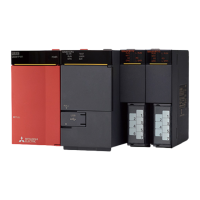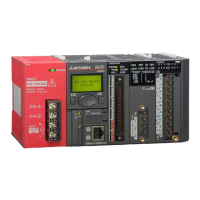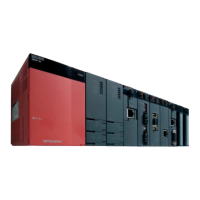15 TYPE CONVERSION FUNCTIONS
15.45 Converting STRING to INT
747
15
15.45 Converting STRING to INT
STRING_TO_INT(_E)
These functions convert STRING type data to INT type data.
■Descriptions, types, and data types
■Operation processing
• These functions convert the STRING type data input to (s) to INT type data and output from (d).
• A value input to (s) is the STRING type data value and within the following range.
■Operation result
1. Function without EN/ENO
The following table lists the operation results.
2. Function with EN/ENO
The following table lists the execution conditions and operation results.
*1 When FALSE is output from ENO, data output from (d) is undefined. In that case, modify a program so that the data output from (d) is
not used.
Ladder diagram Structured text
[Without EN/ENO] [With EN/ENO] [Without EN/ENO]
d:=STRING_TO_INT(s);
[With EN/ENO]
d:=STRING_TO_INT_E(EN,ENO,s);
Argument Description Type Data type
EN Execution condition (TRUE: Execution, FALSE: Stop) Input variable BOOL
s Input Input variable STRING(6)
ENO Output status (TRUE: Normal, FALSE: Abnormal) Output variable BOOL
d Output Output variable INT
• Within the range of "30H" to "39H", "20H", "2DH", and "00H" in ASCII code
• Within the range of "-32768" to "32767" as the STRING type data value
Operation result (d)
No operation error occurred Operation output value
An operation error occurred Indefinite value
Execution condition Operation result
EN ENO (d)
TRUE (Executes operation) TRUE (Operation error did not occur) Operation output value
FALSE (Operation error occurred)
*1
Indefinite value
FALSE (Stops operation) FALSE
*1
Indefinite value
INT
ASCII code for hundreds place ASCII code for thousands place
ASCII code for ones place ASCII code for tens place
00H (Indicates the end of the character string.)
ASCII code for ten-thousands place
Sign data
2nd word
3rd word
4th word
1st word of the character string
High-order byte Low-order byte
(s)
(d)

